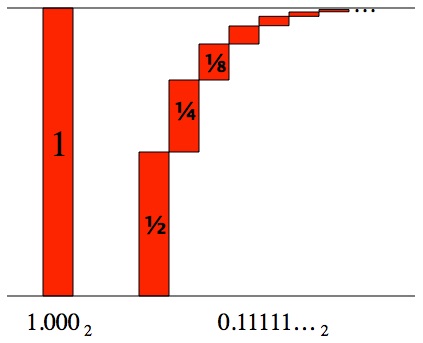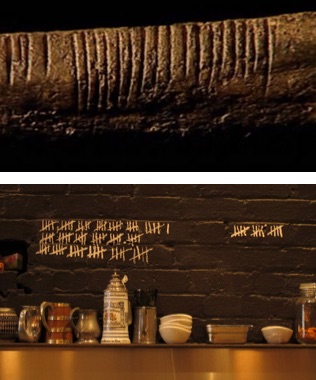Physicist: Yup!
The “0.999… thing” has been done before, but here’s the idea. When we write 0.9, 0.99, 0.999, 0.9999, etc. we’re writing a sequence of numbers that gets closer and closer to 1. Specifically, if there are N 9’s, then . What this means is that no matter how close you want to get to 1, you can get closer than that with enough 9’s. If the 9’s never end, then the difference between 1 and 0.999… is zero. The way our number system is constructed, this means that “0.999…” and “1” (or even “1.000…”) are one and the same in every respect.
As a quick aside, if you think it’s weird that 1 = 0.999…, then you’re in good company. Literally everyone thinks it’s weird. But be cool. There are no grand truths handed down from on high. The rules of math are like the rules of Monopoly; if you don’t like them you can change them, but you risk the “game” becoming inconsistent or merely no fun.
The same philosophy applies to every base. A good way to understand bases is to first consider what it means to write down a number in a given base. For example:
372.51 = 300 + 70 + 2 + 0.5 + 0.01 = 3×102 + 7×101 + 2×100 + 5×10-1 + 1×10-2
As you step to the right along a number, each digit you see is multiplied by a lower power of ten. This is why our number system is called “base 10”. But beyond being convenient to use our fingers to count, there’s nothing special about the number ten. If we could start over (and why not?), base 12 would be a much better choice. For example, 1/3 in base 10 is “0.333…” and in base 12 it’s “0.4”; much nicer. More succinctly: 0.333…10 = 0.412
Because we work in base 10, if you tried to “build a tower to one” from below, you’d want to use the largest possible number each time. 0.910 is the largest one-digit number, o.9910 is the largest two-digit number, 0.99910 is the largest three-digit number, etc. This is because “910” is the largest number in base 10.
In the exact same way, 0.89 is the largest one-digit number in base 9, 0.889 is the largest two-digit number, and so on. The same way that it works in base 10, in base 9: 19 = 0.888…9 !
The easiest way to picture the number 1 as an infinite sum of parts is to picture 0.111…2 , “0.111…” in base 2.

If you cut a stick in half, then cut one of those halves in half, then cut one of those quarters in half, and so on, then the collected set of sticks would have the same length as the original stick. This is the same as saying 1 = 0.111… in base 2.
If you take a stick and cut it in half, then cut one of those halves in half, then cut one of those quarters in half, and so on, the collected set of sticks would have the same length as the original stick. One half, 0.12 , plus 1 quarter, 0.112 , plus 1 eighth, 0.1112 , add infinitum equals one. That is to say, 12 , = 0.111…2 .
But things get tricky when you get to base 1. The largest value in a given base is always less than the base; 9 for base 10, 6 for base 7, 37 for base 38, 1 for base 2. So you’d expect that the largest number in base 1 is 01 . The problem is that the whole idea of a base system breaks down in “base 1”. In base ten, the number “abc.de10 .” means “ax102 + bx101 + cx100 + dx10-1 + ex10-2” (where “a” through “e” are some digits, but who cares what they are). More generally, in base B we have abc.deB = axB2 + bxB1 + cxB0 + dxB-1 + exB-2.
But in base 1, abc.de1 = ax12 + bx11 + cx10 + dx1-1 + ex1-2 = a+b+c+d+e. That is to say, every digit has the same value. Rather than digits to the left being worth more, and digits to the right being worth less, in base 1 every position is the same as every other. So, base one is a number system where the position of the numbers don’t matter and technically the only number you get to work with is zero. Not useful.
If you’re gauche enough to allow the use of the number 1 in base 1, then you can count. But not fast.

Top: The oldest recorded numbers, “4” and “17” in base 1. Bottom: Using a modern abuse of notation, “96” and “15” in base 1.
In base 1, 1 = 10 = 0.000001 = 10000 = 0.01. Therefore, the infinitely repeating number 0.111…1 = ∞. That is, if you add up an infinite number string of 1’s, 1+1+1+1…, then naturally you get infinity.
In short: The “1 = 0.999… thing” is just a symptom of how the our number system is constructed, and has nothing in particular to do with 9’s or 10’s. The base 1 number system is kind of a mess and, outside of tallying, isn’t worth using. Base 1 is broken when we consider this particular problem, but that’s to be expected since it’s usually broken.
Answer Gravy: We can use the definition of the base system to show that 1 = 0.999…10 = 0.333…4 = 0.555…6 etc. For example, when we write the number 0.999… in base 10, what we explicitly mean is
The same idea is true in any base B, . Showing that this is equal to one is a matter of working this around until it looks like a geometric sum,
, and using the fact that
.
Notice that issues with base 1, B=1, crop up twice. First because you’re adding up nothing, 0=B-1, over and over. Second because when B=1. So don’t use base 1. There are better things to do.
The excellent pdf about constructing the real numbers was written by this guy.







7 Responses to Q: In base ten 1=0.999…, but what about in other bases? What about in base 1?